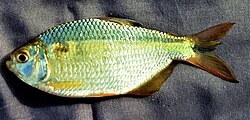| Astyanax | |
|---|---|
 | |
| Astyanax mexicanus | |
| Scientific classification | |
| Kingdom: | Animalia |
| Phylum: | Chordata |
| Class: | Actinopterygii |
| Order: | Characiformes |
| Family: | Acestrorhamphidae |
| Subfamily: | Acestrorhamphinae |
| Genus: | Astyanax S. F. Baird & Girard, 1854 |
| Type species | |
| Astyanax argentatus Baird & Girard, 1854 | |
| Synonyms | |
AnoptichthysHubbs & Innes, 1936 Contents | |
Astyanax is a genus of freshwater fish in the family Acestrorhamphidae of the order Characiformes. [2] Some of these fish, like many of their relatives, are kept as aquarium pets and known collectively as tetras. With around 150 described species and new ones being described yearly, [3] this genus is among the largest of the entire order; Hyphessobrycon also has more than 145 species and which one is larger at any one time depends on whether more species have been recently described in one or the other. The blind and colorless cave tetra of Mexico is a famous member of the genus, but its taxonomic position is disputed: Some recognize it as part of the Mexican tetra (A. mexicanus) and this is supported by phylogenetic evidence, [4] [5] [6] [7] [8] but others recognize the cave form as a separate species, A. jordani . [3]
The type species is A. argentatus, now regarded as a form of the Mexican tetra (A. mexicanus). The generic name comes from Astyanax, a character in Greek mythology, who was the son of Hector of Troy; in homage to this, several specific epithets also refer to the Iliad . [3]







